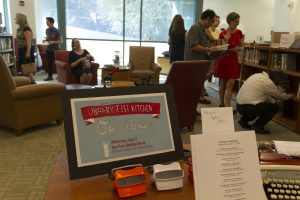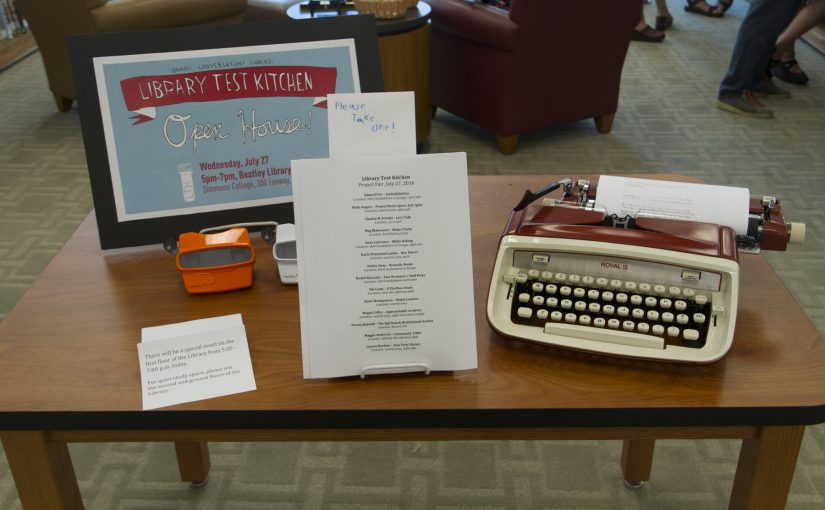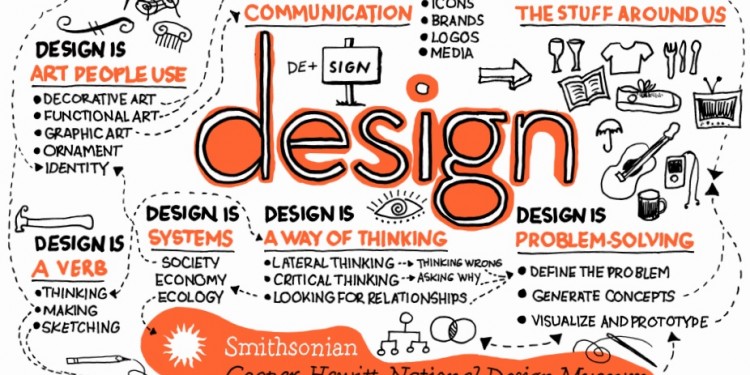Revisiting design thinking and the Library Test Kitchen course at Simmons from the student perspective.
“Who has heard of design thinking?” asked my 438 (Introduction to Archival Methods and Services) professor. I eagerly raised my hand, along with two other students who half-raised their hands, half shrugged their shoulders. After watching a section of the documentary film, Design & Thinking, our class collectively brainstormed a series of challenges associated with the finding aid, such as lack of accessible formats or that they are too often veiled by archival jargon. Then, we divided into groups and were tasked to “redesign the finding aid” by choosing one of the problems and come up with possible solutions. My professor encouraged us to push past the idea of the finding aid as an archivists’ tool and imagine it as something completely different. Our class didn’t reach this point, which makes complete sense and adds further proof to the notion that design thinking is truly a holistic process and even more importantly, a mindset that one needs to adopt. It takes time to settle into a completely new concept, especially one that comes out of the design world, which many students and LIS professionals may feel very far removed from.

I only knew about design thinking because of my research of and work with the team behind the Library Test Kitchen at Simmons School of Library Information Science course, which was offered during the 2016 summer session and is coming back for Summer 2017. I feel privileged to have had knowledge of design thinking swirling around in my mind since September. It is a valuable framework to have access to and a way to approach problems in new ways. If you want to read more about some of the history and fundamentals of design thinking, please see my previous post on the topic.
The original Library Test Kitchen team from Harvard University and Olin College, LTK@Simmons instructor, Candy Schwartz, and Simmons’ Dean Eileen Abels along with Lynne Howarth and Linda Smith, were invested in producing some sort of synthesis of the LTK@Simmons experience from both the student and instructors perspective. This is how my first article about design thinking came to be and this second article incorporates more direct feedback from students. In addition to these written pieces, everyone came together to help produce a short movie about the Library Test Kitchen course at Simmons. Abels, Schwartz, Howarth and Smith, gave a workshop on teaching design thinking at ALISE 2017. Abels, Howarth and Smith are the leaders of a project dedicated to future-focused LIS education and you can read more about that project at this website. I am excited to see that LTK@Simmons is being offered again this summer and only wish that I could take it! My friend and fellow SLIS student Lindsay Deal told me she is taking Library Test Kitchen and when I asked why she signed up for this course, she said:
“I am curious about the design aspect of everything, particularly of libraries…I am also interested in the design of organizing space and information in general. I’m in the IS&T (Information Science and Technology) track and I haven’t taken a library centric class yet, so I’m very excited that this course will be more library focused.”
I also asked her if she had heard of design thinking and if she knew what it meant. She answered that she was not too familiar with the concept but when prompted to come up with a definition, she said that it is about “making things, making something better…making things the most optimal that they can be and making the most efficient use of space.” I’m excited to compare and contrast the first iteration of LTK@Simmons to this summer’s upcoming course. But for now, let’s dive deeper into the experience of LTK@Simmons 2016.

